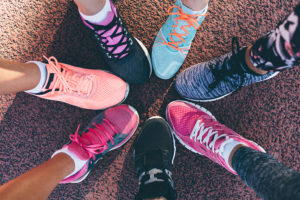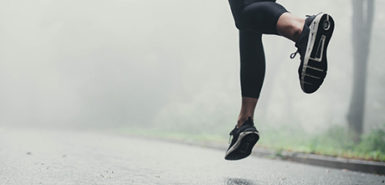
The only equipment you really need to go running are running shoes. But choosing a pair can often feel like a shopping marathon.
There’s no shortage of big box sporting goods stores, but ask the staff at a local running club for suggestions about where to shop. The salespeople at a specialty shoe store should be better able to suggest the right styles for your feet.
Look for lightweight choices. For example, 8 ounces or less for a woman’s size 8, and 10 ounces or less for a man’s size 9.
Our Take
There are many items to take into consideration when planning the perfect run, and the two most important pieces of the puzzle may be the shoes and the socks, noted John Harris, DPM, FACFAS, a Spectrum Health Medical Group orthopedic foot and ankle surgeon.
“Running should be done in running-specific shoes,” Dr. Harris said. “A more cushioned shoe is recommended, and decreases the chance of injury while running on pavement—as opposed to the fad ‘barefoot’ running shoes.”
Avoid stability or motion-control shoes and opt for inserts for cushioned running shoes instead to help with flatfoot issues, he added, noting that only elite runners will need to worry about the weight of the shoe.
“And when it comes to socks, typically a wool blend works best for most runners,” Dr. Harris said.
In addition to these tips, podiatrists recommend people shop later in the afternoon for their perfect running ‘sole’ mate, and realize you might not find the best match on your first excursion.
“When shopping for new running shoes, it’s best to choose a store that offers the ability to return the shoe,” said Brian Buchanan, DPM, FACFAS, a Spectrum Health Medical Group orthopedic foot and ankle specialist. “Many times you cannot determine how comfortable the shoe will be in 5-10 minutes.”
The shoes should have little or no heel-to-toe “drop”—that’s a difference in thickness from the heel cushion to forefoot cushion. And they should be “neutral”—skip any motion control or stability features, which can actually interfere with normal foot motion.
As with all footwear, shop at the end of the day when feet are at their largest. The toe box should be wide enough so you can wiggle your toes and have at least a half-inch of space between them and the front tip of the shoe—about the width of a thumb. Don’t buy a tight shoe thinking it will “give” over time. And, of course, try out your selections in the store.
If you’re replacing an existing pair of running shoes, don’t wait until they’re no longer usable. You want to gradually transition to the new pair. At first, wear them for just a few minutes of each run, and then for longer and longer periods of time.
Some people replace their shoes every 350 miles, but that’s not a hard-and-fast rule. Check the soles daily. If lower layers of material are showing through in spots, you’re overdue.
If you walk rather than run for fitness, you might be most comfortable in a walking shoe, which typically has a more flexible sole, according to Consumer Reports. If you participate in a few different activities, check out cross-trainers rather than buying a separate pair of shoes for each type of exercise.
 /a>
/a>
 /a>
/a>
 /a>
/a>